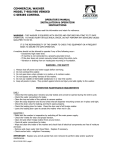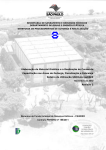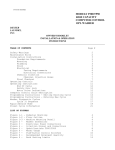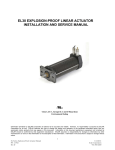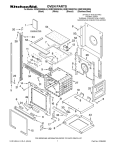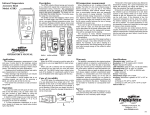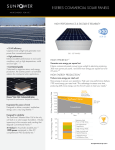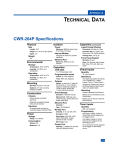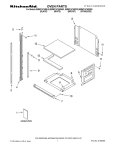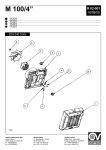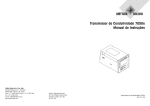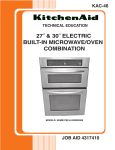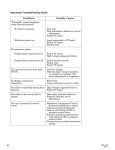Download precautions to be observed before and during
Transcript
Tech Sheet Do not discard WARNING Electrical Shock Hazard Disconnect power before servicing. Replace all parts and panels before operating. Failure to do so can result in death or electrical shock. PRECAUTIONS TO BE OBSERVED BEFORE AND DURING SERVICING TO AVOID POSSIBLE EXPOSURE TO EXCESSIVE MICROWAVE ENERGY a. Do not operate or allow the oven to be operated with the door open. b. Make the following safety checks on all ovens to be serviced before activating the magnetron or other microwave source, and make repairs as necessary: 1. Interlock Operation 2. Proper Door Closing 3. Seal and Sealing Surfaces (Arcing, Wear and Other Damage) 4. Damage to or Loosening of Hinges and Latches 5. Evidence of Dropping or Abuse c. Before turning on microwave power for any service test or inspection within the microwave generating compartments, check the magnetron, waveguide or transmission line, and cavity for proper alignment, integrity and connections. W10268748A / 461965199813 d. Any defective or misadjusted components in the interlock, monitor, door seal, and microwave generation and transmission systems shall be repaired, replaced, or adjusted by procedures described in service manual before the oven is released to the owner. e. A microwave leakage check to verify compliance with the Federal Performance Standard should be performed on each oven prior to release to the owner. f. Do not attempt to operate the oven if the door glass is broken. FOR SERVICE TECHNICIAN’S USE ONLY 2 AC 120V/125V 60Hz Power Cord Cy N 3 W G BK L P2-6 Y/G Turntable Motor FC Motor CL Cavity Light Triac 7104 TT Y HF HL Hood Exhaust Fan Hood (Cooktop) Light L.V. Transformer Black Blue Red Yellow Green FC Relay 4904 W P2-5 Connector Name R Valve Relay 4921 Y P3-5 FCM P2-4 HL Relay 4911 33K P5-2 Magnetron Thermostat BU W TT P5-1 BK BU R Y G MW Relay 4903 1 2 White Brown Orange Yellow/Green Gray Turbo Relay 4910 R Symbol Notes: Wire Color Pin No.--1 P6-1 BR GY P3-1 P3-2 GY BK P3-3 W P3-4 Fuse BU P2-1 HL Relay 4912 GY P2-3 TT Relay 4906 CL Relay 4901 OR P2-7 HF Relay 4922 W HF Relay 4902 Primary Interlock Switch FCM FCTH Diode 6101 Power Resistor BK Golden Tab CL Monitor Interlock Switch FC Heater PCBA BK P6-1 W P6-2 Fuse 20 Amp P5-5 Golden Tab HF White Tab FC Thermostat Secondary Interlock Switch BK R P2-2 Condition: Door Open. Y/G Cavity Thermostat 2 BK W HL R P6-5 R BK HL White Tab Motor Capacitor Y BU P6-3 BK AC Line Filter Cx Cy P5-4 Cavity BU Thermostat 1 BR Dwg No.: MU-099-T - Rev. D 1 L R L 4 Y BU BK Fuse 20 Amp P1 P21 P4 W BR OR Y/G GY Humidity Sensor FC Sensor Hood Thermistor Magnetron FA F H.V. Diode H.V. Capacitor R H.V. Transformer W Red Tube Black Tube H 2 WIRING DIAGRAMS Schematic Diagram Black Tube Parts Layout (not to scale) AC A AB AA B Z C D E F Y T G H X I J K W V L 3551 T P5 U M S N R O Q A. Hood fan motor assembly B. H.V. capacitor C. AC line filter D. Magnetron thermostat—opens at 257ºF (125ºC), closes at 185ºF (85ºC) E. Magnetron F. Cavity thermostat 1—opens at 275ºF (135ºC), closes at -31ºF (-35ºC) G. Cavity thermostat 2—opens at 275ºF (135ºC), closes at -31ºF (-35ºC) H. Humidity sensor N M P I. H.V. transformer J. FC thermoactuator K. H.V. diode L. Power resistor M. Fuse holders N. Line fuses O. Motor capacitor P. Hood thermistor Q. Electronic control R. Touch panel S. Secondary interlock switch T. Light holders U. Hood (cooktop) light V. Monitor interlock switch W. Primary interlock switch X. Turntable motor Y. Cavity light Z. FC thermostat—opens at 329ºF (165ºC), closes at 257ºF (125ºC) AA. FC thermistor AB. FC ring heater AC. FC motor Primary, Secondary, and Monitor Interlock Switch Checkout Procedures Switch Check By Primary Interlock 1. Unplug microwave oven or disconnect power. 2. Disconnect the wires at the Primary Interlock Switch. 3. Check from the common terminal (black/brown wires) to the normally open terminal (black/white wires). - + 1. Unplug microwave oven or disconnect power. 2. Disconnect the wires at the Primary Interlock Switch. 3. Check from the common terminal (black/brown wires) to the normally closed terminal (orange wire). + - 1. Unplug microwave oven or disconnect power. 2. Disconnect the wires at the Secondary Interlock Switch. 3. Check from the common terminal (blue/white wires) to the normally open terminal (blue/red wires). - + Secondary Interlock Door Open Door Closed 3 Primary, Secondary, and Monitor Interlock Switch Checkout Procedures Switch Check By Door Open Monitor Interlock 1. Unplug microwave oven or disconnect power. 2. Disconnect the wires at the Monitor Interlock Switch. 3. Check from the common terminal (white/white wires) to the normally closed terminal (blue/white wires). Door Closed + - (+) Continuity (-) No Continuity NOTE: These diagrams are not intended to show a complete circuit; they represent the position of switches during “DOOR OPEN” or “DOOR CLOSED” (continuity checks only). Door Closed L (NC) Door Open (NO) Primary Interlock Switch N (NO) (NC) Monitor Interlock Switch L (NO) Secondary Interlock Switch (NC) N (NO) (NO) (NC) Primary Interlock Switch Monitor Interlock Switch (NO) Secondary Interlock Switch TROUBLESHOOTING Do not continue with the diagnostics of appliance if the household fuse is blown, a circuit breaker is tripped or if there is less than 120-volt power supply at the wall outlet. Complete the following steps before checking microwave oven circuitry: 1. Unplug microwave oven or disconnect power. 2. Discharge high-voltage capacitor and disconnect white wire from power transformer. 3. Check for loose wiring or incorrect wiring within microwave oven. 4. All testing must be done with an ohmmeter having a sensitivity of 20,000 ohms per volt DC or greater, and powered by at least a 9-volt battery. 5. All operational checks using microwave energy must be done with the microwave oven loaded with a minimum of 8 oz (250 mL) of water in a microwave-safe container. Microwave (Non-sensor) Cooking BR OR L BK Filter Fuse Cavity Thermostat 2 20 Amp BK BK BK BK Electronic Control L.V. Transformer P2-4 P2-7 2 BU P2-1 BU Magnetron Thermostat Cavity Secondary H.V. Interlock Thermostat 1 Transformer BR W W BU BU Switch R Fuse 20 Amp Turntable Motor BU BU R BK TT P2-2 P5-1 P5-2 W BU Cavity Light Turbo Relay 4910 MW Relay 4903 Primary Interlock Switch P5-4 Filter TT Relay 4906 CL Relay 4901 P2-3 HF Triac 7104 HF Relay 4902 GY P3-2 P3-1 HF Relay 4922 GY Power Resistor 4 P3-3 P3-4 GY CL P6-1 BK BK W W BU BU Y R Motor Capacitor P6-5 Y R HF N W Microwave Sensor Cooking BR L BK Filter Cavity Thermostat 2 BK BK P2-7 BK 2 Fuse 20 Amp BK Turbo Relay 4910 MW Relay 4903 Primary Interlock Switch TT Relay 4906 BR R Fuse 20 Amp P2-2 R H 1 Humidity Sensor P5-4 BU P2-1 P2-4 OR BK P5-1 Cavity Light CL Relay 4901 GY P2-3 Turntable Motor BU TT P5-2 W N P6-1 BK BK W BU Y P3-4 P3-2 P3-1 GY BU W P3-3 HF Relay 4902 BU CL HF Triac 7104 HF Relay 4922 BU Magnetron Thermostat Secondary H.V. Cavity Interlock Transformer Thermostat 1 BU BU Switch W W Filter Electronic Control L.V. Transformer W BU Y R HF R P6-5 Motor Capacitor GY Power Resistor FC Heater Circuit L Filter BK Cavity Thermostat 2 BK BK Electronic Control Fuse 20 Amp BK W Primary Interlock Switch W Monitor Interlock Switch FC Thermostat W FC Heater W FC Relay 4904 W R Cavity Thermostat 1 BU N Filter W Secondary Interlock Switch FC Motor and Thermal Actuator Circuit L Filter BK Cavity Thermostat 2 BK BK Fuse 20 Amp BK FC Motor W BK W Primary Interlock Switch Monitor Interlock Switch Electronic Control M BK Valve Relay 4921 BK Y P3-5 BU P2-1 BU W Cavity Thermostat 1 BU Filter N W Secondary Interlock Switch Thermal Actuator Hood Exhaust Fan on High Automatically Filter BK Cavity Fuse Thermostat 2 20 Amp BK BK Electronic Control BK BR L.V. Transformer P2-4 Cavity Thermostat 1 P2-1 HF Triac 7104 P3-3 HF Relay 4922 HF Relay 4902 BU P5-4 W W BU BK BK P6-1 BU BU Y Y R R P4 BU Motor Capacitor HF BU Filter L N W P6-5 Hood Thermistor 5 Hood Exhaust Fan on Low Speed Manually L BK Filter Cavity Thermostat 2 BK BK Electronic Control Fuse 20 Amp BK BR L.V. Transformer P2-4 P2-1 BU P5-4 Cavity Thermostat 1 BU BU W W BU HF Triac 7104 W P3-4 GY P6-2 GY W BU BU Y R HF Filter HF Relay 4902 P3-2 P3-1 HF Relay 4922 N W Y R P6-5 Motor Capacitor Power Resistor Hood Exhaust Fan on Medium Low and Medium Speed Manually BK Filter Cavity Thermostat 2 BK BK Electronic Control Fuse 20 Amp BK BR P2-4 L.V. Transformer P2-1 BU P5-4 HF Triac 7104 W P3-4 HF Relay 4922 HF Relay 4902 Cavity Thermostat 1 BU BU W W BU P6-2 W BU BU Y R HF Filter L N W Y R P6-5 Motor Capacitor Hood Exhaust Fan on High / Medium Manually Filter BK Cavity Thermostat 2 BK BK Electronic Control Fuse 20 Amp BK BR L.V. Transformer P2-1 P2-4 BU P5-4 HF Triac 7104 P3-3 HF Relay 4922 HF Relay 4902 BK W W BU BK BU BU Y R Y R Motor Capacitor 6 P6-1 P6-5 Cavity Thermostat 1 BU BU HF Filter L N W Microwave Oven Plugged In—Time of Day Displayed L Filter BK Cavity Fuse Thermostat 2 20 Amp BK BK BK Electronic Control L.V. Transformer BR P2-4 P2-1 BU P5-4 Cavity Thermostat 1 BU W BU Filter N W Door Open—Oven Cavity Light Is On Electronic Control BR L BK Filter Cavity Thermostat 2 BK BK Fuse 20 Amp OR BK L.V. Transformer P2-4 P2-1 P2-7 CL Relay 4901 P2-3 Primary Interlock Switch BU P5-4 GY BU W CL Cavity Thermostat 1 BU W Filter N W BU Cavity Light Cooktop Light on High Electronic Control L BK Filter Cavity Fuse Thermostat 2 20 Amp BK BK BK BR L.V. Transformer P2-4 Cavity Thermostat 1 P5-4 BU BU P2-1 W N Filter BU W W HL Relay 4911 P2-6 Y P5-5 R HL Hood (Cooktop) Light Cooktop Light on Low (Night Light) L BK Filter Fuse Cavity Thermostat 2 20 Amp BK BK Electronic Control BK BR L.V. Transformer P2-4 P5-4 BU P2-1 BU Cavity Thermostat 1 BU W Filter N W W HL Relay 4912 Diode 6101 P2-6 Y P5-5 R HL Hood (Cooktop) Light 7 Touch Panel Touch Panel and Electronic Control Test The microwave hood combination is provided with a self-diagnostic routine that can be accessed through the touch keypad. To initiate this routine: 1. Press and hold the STOP/CLEAR button while opening the door. 2. While still holding the STOP/CLEAR button, unplug the microwave oven for 2 seconds, then plug it back in. All VFD segments will be lit to indicate the test mode has been entered. 3. Release the STOP/CLEAR button and close the door. NOTE: When the door is closed, if the STOP/CLEAR button is pressed during this diagnostic routine, you will exit the test mode. Key Tables for Test Mode Key Name Function Display Buzzer Key Name Start - - 1 beep Baked Potato - Setup Menu NTC Sensor Check NTC Message 1 beep Dinner Plate Light - Key 03 1 beep Vent Fan - Key 04 1 beep Timer Set/Off - Key 05 1 beep Warm Hold - Key 06 1 beep Clock - Key 07 1 beep Turntable On/Off - Key 09 Function Display Buzzer Key 31 1 beep - Key 32 1 beep Quick Defrost - Key 36 1 beep 0 Microwave Oven On (1100 W) for 10 Seconds— Relay 4903 & Relay 4910-NO MW TB 1 beep 1 Cavity Light On— Relay 4901 CL 1 beep 2 Cavity Light & Turntable TT On—Relay 4901 & Relay 4906 1 beep 3 Microwave Oven On (1000W) for 10 Seconds— Relay 4903 & Relay 4910-NC MW 1 beep 4 FC Heater On for 10 Seconds— Relay 4904 FC 1 beep Add 30 Sec - Key 20 1 beep Cook Time - Key 21 1 beep Cook Power - Key 22 1 beep Cook Test Humidity Humidity Sensor 1 beep Sensor Message Reheat - Key 24 1 beep Defrost - Key 25 1 beep 5 FC Fan On—Relay 4921 FC-FAN Kids Menu - Key 26 1 beep 6 Cooktop Light On (High)—Relay 4911 HL_HIGH 1 beep 7 Cooktop Light On (Low)—Relay 4912 HL_LOW 1 beep 8 Hood Fan On (High HF_HIGH 1 beep Speed)— Relay 4902, Relay 4922 & Triac 7104 9 Hood Fan On (Low Speed)— Relay 4902 & Triac 7104 HF_LOW 1 beep Stop/Clear Exit Test Mode to Standby - Soften/Melt - Key 29 1 beep Convect Bake Test FC Sensor FC Sensor Message 1 beep Convect Roast - Key 2B 1 beep Steam/Simmer - Key 2D 1 beep Popcorn - Key 30 1 beep 8 1 beep 1 beep Microwave Oven Power Output Test 1. Place 8 oz (250 mL) of lukewarm water in the center of the microwave oven. 2. Operate on HIGH power level for 2 minutes. Water should be hot. NOTE: If the water takes longer than 2 minutes to heat, this may indicate either the operating voltage is lower than 110 volts or there is a problem with the microwave oven. Failure Codes Indications NOTE: Many of the problems listed in the chart below may be solved by power cycling: Unplug microwave oven or disconnect power. After 1 minute, plug in microwave oven or reconnect power. Display Likely Failure Condition Recommended Repair Procedure Flashing colon “:” Power failure After a power failure, the colon “:” will be flashing. Press any key to end this indication. The colon will then be steady when in standby. F2 Touch panel failure 1. 2. 3. 4. 5. 6. 7. 8. Unplug microwave oven or disconnect power. Replace touch panel. Replace all parts and panels before operating. Plug in microwave oven or reconnect power. If problem persists, unplug microwave oven or disconnect power. Replace electronic control. Replace all parts and panels before operating. Plug in microwave oven or reconnect power. F3C Cavity temperature sensor failure 1. 2. 3. 4. 5. 6. 7. 8. 9. Unplug microwave oven or disconnect power. Check cavity temperature sensor connection. Replace the cavity temperature sensor. Replace all parts and panels before operating. Plug in microwave oven or reconnect power. If problem persists, unplug microwave oven or disconnect power. Replace electronic control. Replace all parts and panels before operating. Plug in microwave oven or reconnect power. F3H Humidity sensor failure 1. 2. 3. 4. 5. F6 MW relay 1. Unplug microwave oven or disconnect power. 2. Check the cable to Relay 4903. 3. Check to see if the relay (4903 on relay electronic control) contact has welded closed. 4. Replace all parts and panels before operating. 5. Plug in microwave oven or reconnect power. 6. If problem persists, unplug microwave oven or disconnect power. 7. Replace electronic control. 8. Replace all parts and panels before operating. 9. Plug in microwave oven or reconnect power. Unplug microwave oven or disconnect power. Connect a new humidity sensor to the electronic control (at P1). Replace all parts and panels before operating. Plug in microwave oven or reconnect power. If no failure code appears when starting sensor function, unplug microwave oven or disconnect power. 6. Replace humidity sensor. 7. Replace all parts and panels before operating. 8. Plug in microwave oven or reconnect power. 9. If failure code appears when starting sensor function, unplug microwave oven or disconnect power. 10. Replace electronic control. 11. Replace all parts and panels before operating. 12. Plug in microwave oven or reconnect power. 9 Component Tests IMPORTANT: ■ Unplug microwave oven or disconnect power. ■ Remove the lead wires from the related component before conducting any of the following tests. ■ Discharge the high-voltage capacitor and remove the lead wires from the primary winding of the high-voltage transformer before conducting any of the following tests. ■ All operational checks using microwave energy must be done with the microwave oven loaded with a minimum of 8 oz (250 mL) of water in a microwave-safe container. ■ Conduct a microwave energy test after performing any tests or repairs to the microwave oven. ■ Check that all wire leads are in the correct positions before operating the microwave oven. ■ Grasp wire connectors when removing the wire leads from microwave oven parts. ■ All testing must be done with an ohmmeter having a sensitivity of 20,000 ohms per volt DC or greater, and powered by at least a 9-volt battery. Components Test/Results H.V. Transformer 1. Unplug microwave oven or disconnect power. 2. Remove wire leads. 3. Measure resistance: ■ Primary winding: Less than 0.5 ohm (approximate) ■ Secondary winding: 90 ohms (approximate) ■ Filament winding: 0 ohms 4. Measure resistance: ■ Primary winding to grounding: Normal: Infinite ■ Filament winding to grounding: Normal: Infinite Filament (orange/red wires) Primary Secondary (white wire ground to transformer case) Magnetron 1. Unplug microwave oven or disconnect power. 2. Remove wire leads. Check that the seal is in good condition. 3. Measure resistance: ■ Filament terminal: Normal: Less than 1 ohm 4. Measure resistance: ■ Filament to chassis: Normal: Infinite H.V. Capacitor 1. Unplug microwave oven or disconnect power. 2. Remove wire leads. 3. Measure resistance: ■ Terminal to terminal: Normal: Momentarily indicates several ohms, and then gradually returns to infinite. ■ Terminal to case: Normal: Infinite H.V. Diode NOTE: Some inexpensive meters may indicate infinite resistance in both directions. 1. Unplug microwave oven or disconnect power. 2. Measure resistance: ■ Forward: Normal: Continuity; Abnormal: Infinite ■ Reverse: Normal: Infinite; Abnormal: Continuity Turntable Motor 1. Unplug microwave oven or disconnect power. 2. Remove wire leads. 3. Measure resistance: ■ Normal: 2.7k-3.8k ohms (approximate) ■ Abnormal: Infinite Motor Capacitor 1. Unplug microwave oven or disconnect power. 2. Remove wire leads. 3. Measure resistance: ■ Normal: Momentarily 0 ohms, then goes to infinite ■ Abnormal: Infinite 10 Components Test/Results Humidity Sensor 1. Unplug microwave oven or disconnect power. 2. Remove the 3-pin connector from the electronic control (P1). NOTE: Do not remove the attached resistor, which is used for internal resistance calibration. 3. Measure resistance across pins 1 & 3, and across pins 2 & 3: ■ Normal: 2.8k ohms (approximate) at 77ºF (28ºC) +/- 18ºF (-10ºC) ■ Abnormal: Infinite W R BK Resistor 1. Unplug microwave oven or disconnect power. 2. Remove wire leads. 3. Measure resistance: ■ High Speed—Normal: Red (R) and Blue (BU) wires: 80 ohms (approximate); Blue (BU) and Black (BK) wires: 35 ohms (approximate); Abnormal: Infinite ■ Low Speed—Normal: Red (R) and Blue (BU) wires: 80 ohms (approximate); Blue (BU) and White (W) wires: 60 ohms (approximate); Abnormal: Infinite Hood Thermistor 1. If “NTC SHORT, CALL FOR SERVICE” or “NTC OPEN, CALL FOR SERVICE” scrolls on display, unplug microwave oven or disconnect power. 2. Measure resistance: ■ Normal: 10k ohms +/- 5% at 77ºF (25ºC) ■ Abnormal: Infinite/continuity P5 355 1 Hood Exhaust Fan Motor FC Ring Heater 1. Unplug microwave oven or disconnect power. 2. Remove wire leads. 3. Measure resistance: ■ Normal: 9 +/- 3 ohms ■ Abnormal: Infinite FC Thermistor 1. Unplug microwave oven or disconnect power. 2. Remove wire leads. 3. Measure resistance: ■ Normal: 230k +/- 20% ohm at 77ºF (25ºC) ■ Abnormal: Infinite FC Thermoactuator 1. Unplug microwave oven or disconnect power. 2. Remove wire leads. 3. Measure resistance: ■ Normal: 1.2k +/- 0.5k ohms ■ Abnormal: Infinite FC Motor 1. Unplug microwave oven or disconnect power. 2. Remove wire leads. 3. Measure resistance: ■ Normal: 20 +/- 2 ohms ■ Abnormal: Infinite AC Line Filter 2 1 3 1 L 3 U 2 N 4 4 Thermostats FC Thermostats Cavity Thermostats Magnetron Thermostat 1. Unplug microwave oven or disconnect power. 2. Remove wire leads. 3. Measure resistance: ■ Normal: 1-3 (coil): Less than 1 ohm; 2-4 (coil): Less than 1 ohm; 3-4 (resistor): 550k-800k ohms ■ Abnormal: Infinite NOTE: Refer to “Parts Layout” for opening and closing temperatures. 1. Unplug microwave oven or disconnect power. 2. Remove wire leads. 3. Measure continuity: ■ Normal: Continuity ■ Abnormal: Infinite 11 W10268748A / 461965199813 © 2009. All rights reserved. 6/09 FOR SERVICE TECHNICIAN’S USE ONLY












